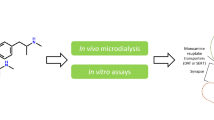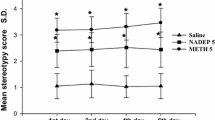Abstract
Rationale
Psychoactive-substituted phenethylamines 2,5-dimethoxy-4-chlorophenethylamine (2C-C); 2,5-dimethoxy-4-methylphenethylamine (2C-D); 2,5-dimethoxy-4-ethylphenethylamine (2C-E); 2,5-dimethoxy-4-iodophenethylamine (2C-I); 2,5-dimethoxy-4-ethylthiophenethylamine (2C-T-2); and 2,5-dimethoxy-4-chloroamphetamine (DOC) are used recreationally and may have deleterious side effects.
Objectives
This study compares the behavioral effects and the mechanisms of action of these substituted phenethylamines with those of hallucinogens and a stimulant.
Methods
The effects of these compounds on mouse locomotor activity and in rats trained to discriminate dimethyltryptamine, (−)-DOM, (+)-LSD, (±)-MDMA, and S(+)-methamphetamine were assessed. Binding and functional activity of the phenethylamines at 5-HT1A, 5-HT2A, 5-HT2C receptors and monoamine transporters were assessed using cells heterologously expressing these proteins.
Results
The phenethylamines depressed mouse locomotor activity, although 2C-D and 2C-E stimulated activity at low doses. The phenethylamines except 2C-T-2 fully substituted for at least one hallucinogenic training compound, but none fully substituted for (+)-methamphetamine. At 5-HT1A receptors, only 2C-T-2 and 2C-I were partial-to-full very low potency agonists. In 5-HT2A arachidonic acid release assays, the phenethylamines were partial to full agonists except 2C-I which was an antagonist. All compounds were full agonists at 5-HT2A and 5-HT2C receptor inositol phosphate assays. Only 2C-I had moderate affinity for, and very low potency at, the serotonin transporter.
Conclusions
The discriminative stimulus effects of 2C-C, 2C-D, 2C-E, 2C-I, and DOC were similar to those of several hallucinogens, but not methamphetamine. Additionally, the substituted phenethylamines were full agonists at 5-HT2A and 5-HT2C receptors, but for 2C-T-2, this was not sufficient to produce hallucinogen-like discriminative stimulus effects. Additionally, the 5-HT2A inositol phosphate pathway may be important in 2C-I's psychoactive properties.




Similar content being viewed by others
References
Acuna-Castillo C, Villalobos C, Moya PR, Saez P, Cassels BK, Huidobro-Toro JP (2002) Differences in potency and efficacy of a series of phenylisopropylamine/phenylethylamine pairs at 5-HT(2A) and 5-HT(2C) receptors. Br J Pharmacol 136:510–519
Backstrom JR, Chang MS, Chu H, Niswender CM, Sanders-Bush E (1999) Agonist-directed signaling of serotonin 5-HT2C receptors: differences between serotonin and lysergic acid diethylamide (LSD). Neuropsychopharmacology 21:77S–81S
Baker LE, Broadbent J, Michael EK, Matthews PK, Metosh CA, Saunders RB, West WB, Appel JB (1995) Assessment of the discriminative stimulus effects of the optical isomers of ecstasy (3,4-methylenedioxymethamphetamine; MDMA). Behav Pharmacol 6:263–275
Berg KA, Maayani S, Goldfarb J, Scaramellini C, Leff P, Clarke WP (1998) Effector pathway-dependent relative efficacy at serotonin type 2A and 2C receptors: evidence for agonist-directed trafficking of receptor stimulus. Mol Pharmacol 54:94–104
Bosak A, Lovecchio F, Levine M (2013) Recurrent seizures and serotonin syndrome following "2C-I" ingestion. J Med Toxicol 9(2):196–198
Cheng Y, Prusoff WH (1973) Relationship between the inhibition constant (K1) and the concentration of inhibitor which causes 50 per cent inhibition (I50) of an enzymatic reaction. Biochem Pharmacol 22:3099–3108
Cohen S (1967) Psychotomimetic agents. Annu Rev Pharmacol 7:301–318
de Boer D, Bosman I (2004) A new trend in drugs-of-abuse; the 2C-series of phenethylamine designer drugs. Pharm World Sci 26:110–113
DEA (2013) DEA Title 21 Code of federal regulations, Section 1308.11 Schedule 1(d) hallucinogenic substances. http://www.deadiversion.usdoj.gov/21cfr/cfr/1308/1308_11.htm. Accessed 3 Sept 2013
Dean BV, Stellpflug SJ, Burnett AM, Engebretsen KM (2013) 2C or not 2C: phenethylamine designer drug review. J Med Toxicol 9:172–178
Drees JC, Stone JA, Wu AH (2009) Morbidity involving the hallucinogenic designer amines MDA and 2C-I. J Forensic Sci 54:1485–1487
Egan C, Grinde E, DuPre A, Roth BL, Hake M, Teitler M, Herrick-Davis K (2000) Agonist high and low affinity state ratios predict drug intrinsic activity and a revised ternary complex mechanism at serotonin 5-HT(2A) and 5-HT(2C) receptors. Synapse 35:144–150
Eshleman AJ, Carmolli M, Cumbay M, Martens CR, Neve KA, Janowsky A (1999) Characteristics of drug interactions with recombinant biogenic amine transporters expressed in the same cell type. J Pharmacol Exp Ther 289:877–885
Eshleman AJ, Wolfrum KM, Hatfield MG, Johnson RA, Murphy KV, Janowsky A (2013) Substituted methcathinones differ in transporter and receptor interactions. Biochem Pharmacol 85:1803–1815
Fantegrossi WE, Harrington AW, Eckler JR, Arshad S, Rabin RA, Winter JC, Coop A, Rice KC, Woods JH (2005) Hallucinogen-like actions of 2,5-dimethoxy-4-(n)-propylthiophenethylamine (2C-T-7) in mice and rats. Psychopharmacology (Berl) 181:496–503
Fantegrossi WE, Murnane KS, Reissig CJ (2008) The behavioral pharmacology of hallucinogens. Biochem Pharmacol 75:17–33
Fiorella D, Rabin RA, Winter JC (1995) The role of the 5-HT2A and 5-HT2C receptors in the stimulus effects of hallucinogenic drugs. I: antagonist correlation analysis. Psychopharmacology (Berl) 121:347–356
Gatch MB, Rutledge MA, Carbonaro T, Forster MJ (2009) Comparison of the discriminative stimulus effects of dimethyltryptamine with different classes of psychoactive compounds in rats. Psychopharmacology (Berl) 204:715–724
Gatch MB, Forster MJ, Janowsky A, Eshleman AJ (2011) Abuse liability profile of three substituted tryptamines. J Pharmacol Exp Ther 338:280–289
Glennon RA, Titeler M, McKenney JD (1984) Evidence for 5-HT2 involvement in the mechanism of action of hallucinogenic agents. Life Sci 35:2505–2511
Halberstadt AL, Geyer MA (2011) Multiple receptors contribute to the behavioral effects of indoleamine hallucinogens. Neuropharmacology 61:364–381
Johnson MP, Mathis CA, Shulgin AT, Hoffman AJ, Nichols DE (1990) [125I]-2-(2,5-dimethoxy-4-iodophenyl)aminoethane ([125I]-2C-I) as a label for the 5-HT2 receptor in rat frontal cortex. Pharmacol Biochem Behav 35:211–217
Knight AR, Misra A, Quirk K, Benwell K, Revell D, Kennett G, Bickerdike M (2004) Pharmacological characterisation of the agonist radioligand binding site of 5-HT(2A), 5-HT(2B) and 5-HT(2C) receptors. Naunyn Schmiedebergs Arch Pharmacol 370:114–123
Krebs KM, Geyer MA (1994) Cross-tolerance studies of serotonin receptors involved in behavioral effects of LSD in rats. Psychopharmacology (Berl) 113:429–437
Krebs-Thomson K, Paulus MP, Geyer MA (1998) Effects of hallucinogens on locomotor and investigatory activity and patterns: influence of 5-HT2A and 5-HT2C receptors. Neuropsychopharmacology 18:339–351
Kurrasch-Orbaugh DM, Watts VJ, Barker EL, Nichols DE (2003) Serotonin 5-hydroxytryptamine 2A receptor-coupled phospholipase C and phospholipase A2 signaling pathways have different receptor reserves. J Pharmacol Exp Ther 304:229–237
Li JX, Koek W, Rice KC, France CP (2010) Differential effects of serotonin 5-HT1A receptor agonists on the discriminative stimulus effects of the 5-HT2A receptor agonist 1-(2,5-dimethoxy-4-methylphenyl)-2-aminopropane in rats and rhesus monkeys. J Pharmacol Exp Ther 333:244–252
McLean TH, Parrish JC, Braden MR, Marona-Lewicka D, Gallardo-Godoy A, Nichols DE (2006) 1-Aminomethylbenzocycloalkanes: conformationally restricted hallucinogenic phenethylamine analogues as functionally selective 5-HT2A receptor agonists. J Med Chem 49:5794–5803
Moya PR, Berg KA, Gutierrez-Hernandez MA, Saez-Briones P, Reyes-Parada M, Cassels BK, Clarke WP (2007) Functional selectivity of hallucinogenic phenethylamine and phenylisopropylamine derivatives at human 5-hydroxytryptamine (5-HT)2A and 5-HT2C receptors. J Pharmacol Exp Ther 321:1054–1061
Nagai F, Nonaka R, Satoh Hisashi KK (2007) The effects of non-medically used psychoactive drugs on monoamine neurotransmission in rat brain. Eur J Pharmacol 559:132–137
National Research Council (2003) Guidelines for the care and use of mammals in neuroscience and behavioral research. The National Academies Press, Washington, DC
Newman-Tancredi A, Gavaudan S, Conte C, Chaput C, Touzard M, Verriele L, Audinot V, Millan MJ (1998) Agonist and antagonist actions of antipsychotic agents at 5-HT1A receptors: a [35S]GTPgammaS binding study. Eur J Pharmacol 355:245–256
Nichols DE (1986a) Differences between the mechanism of action of MDMA, MBDB, and the classic hallucinogens. Identification of a new therapeutic class: entactogens. J Psychoactive Drugs 18:305–313
Nichols DE (1986b) Studies of the relationship between molecular structure and hallucinogenic activity. Pharmacol Biochem Behav 24:335–340
Nichols DE (2004) Hallucinogens. Pharmacol Ther 101:131–181
Nonaka R, Nagai F, Ogata A, Satoh K (2007) In vitro screening of psychoactive drugs by [(35)S]GTPgammaS binding in rat brain membranes. Biol Pharm Bull 30:2328–2333
Oberlender R, Nichols DE (1988) Drug discrimination studies with MDMA and amphetamine. Psychopharmacology (Berl) 95:71–76
Ovaska H, Viljoen A, Puchnarewicz M, Button J, Ramsey J, Holt DW, Dargan PI, Wood DM (2008) First case report of recreational use of 2,5-dimethoxy-4-chloroamphetamine confirmed by toxicological screening. Eur J Emerg Med 15:354–356
Parrish JC, Braden MR, Gundy E, Nichols DE (2005) Differential phospholipase C activation by phenylalkylamine serotonin 5-HT 2A receptor agonists. J Neurochem 95:1575–1584
Rabin RA, Regina M, Doat M, Winter JC (2002) 5-HT2A receptor-stimulated phosphoinositide hydrolysis in the stimulus effects of hallucinogens. Pharmacol Biochem Behav 72:29–37
Raymond JR, Mukhin YV, Gelasco A, Turner J, Collinsworth G, Gettys TW, Grewal JS, Garnovskaya MN (2001) Multiplicity of mechanisms of serotonin receptor signal transduction. Pharmacol Ther 92:179–212
Sacks J, Ray MJ, Williams S, Opatowsky MJ (2012) Fatal toxic leukoencephalopathy secondary to overdose of a new psychoactive designer drug 2C-E ("Europa"). Proc (Bayl Univ Med Cent) 25:374–376
Sanders-Bush E, Burris KD, Knoth K (1988) Lysergic acid diethylamide and 2,5-dimethoxy-4-methylamphetamine are partial agonists at serotonin receptors linked to phosphoinositide hydrolysis. J Pharmacol Exp Ther 246:924–928
Schechter MD (1998) MDMA-like stimulus effects of hallucinogens in male Fawn-Hooded rats. Pharmacol Biochem Behav 59:265–270
Schindler EA, Harvey JA, Aloyo VJ (2013) Phospholipase C mediates (+/−)-1-(2,5-dimethoxy-4-iodophenyl)-2-aminopropane (DOI)-, but not lysergic acid diethylamide (LSD)-elicited head bobs in rabbit medial prefrontal cortex. Brain Res 1491:98–108
Shulgin AT, Shulgin A (1991) Pihkal: a chemical love story. Transform, Berkeley, CA
Titeler M, Lyon RA, Glennon RA (1988) Radioligand binding evidence implicates the brain 5-HT2 receptor as a site of action for LSD and phenylisopropylamine hallucinogens. Psychopharmacology (Berl) 94:213–216
Toll L, Berzetei-Gurske IP, Polgar WE, Brandt SR, Adapa ID, Rodriguez L, Schwartz RW, Haggart D, O'Brien A, White A, Kennedy JM, Craymer K, Farrington L, Auh JS (1998) Standard binding and functional assays related to medications development division testing for potential cocaine and opiate narcotic treatment medications. NIDA Res Monogr 178:440–466
Van Vrancken MJ, Benavides R, Wians FH Jr (2013) Identification of designer drug 2C-E (4-ethyl-2, 5-dimethoxy-phenethylamine) in urine following a drug overdose. Proc (Bayl Univ Med Cent) 26:58–61
Villalobos CA, Bull P, Saez P, Cassels BK, Huidobro-Toro JP (2004) 4-Bromo-2,5-dimethoxyphenethylamine (2C-B) and structurally related phenylethylamines are potent 5-HT2A receptor antagonists in Xenopus laevis oocytes. Br J Pharmacol 141:1167–1174
Winter JC (2009) Hallucinogens as discriminative stimuli in animals: LSD, phenethylamines, and tryptamines. Psychopharmacology (Berl) 203:251–263
Acknowledgments
Funding for this study was provided by National Institutes of Health National Institute on Drug Abuse/Veterans Affairs Interagency agreements (Y1 DA 5007–05, Y1-DA-0101-01), The Methamphetamine Abuse Research Center (P50 DA018165), the Veterans Affairs Research Career and Merit Review programs, and by the National Institute on Drug Abuse contracts (N01DA2-8822 and N01DA-7-8872). The NIDA project officers contributed to study design and had no further role in the collection, analysis, and interpretation of data, in the writing of the report, or in the decision to submit the paper for publication.
Conflict of interest
All authors declare that they have no conflicts of interest.
Author information
Authors and Affiliations
Corresponding author
Rights and permissions
About this article
Cite this article
Eshleman, A.J., Forster, M.J., Wolfrum, K.M. et al. Behavioral and neurochemical pharmacology of six psychoactive substituted phenethylamines: mouse locomotion, rat drug discrimination and in vitro receptor and transporter binding and function. Psychopharmacology 231, 875–888 (2014). https://doi.org/10.1007/s00213-013-3303-6
Received:
Accepted:
Published:
Issue Date:
DOI: https://doi.org/10.1007/s00213-013-3303-6




